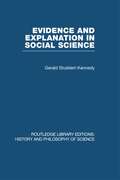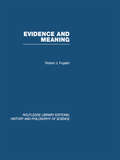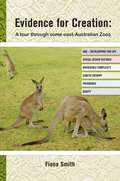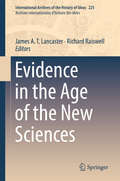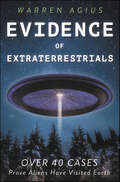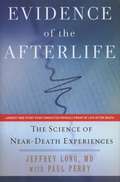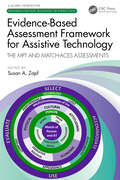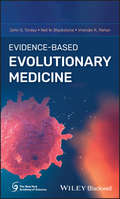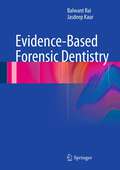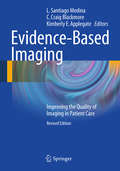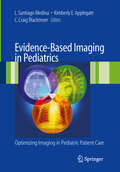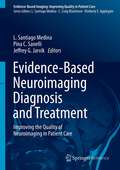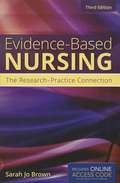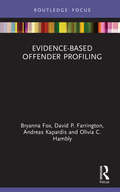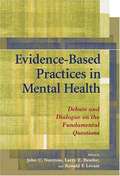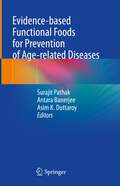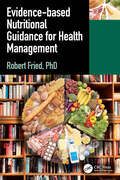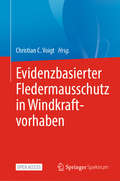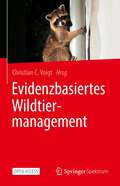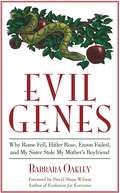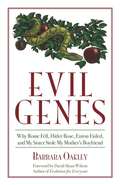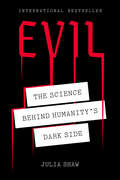- Table View
- List View
Evidence and Evolution
by Elliott SoberHow should the concept of evidence be understood? And how does the concept of evidence apply to the controversy about creationism as well as to work in evolutionary biology about natural selection and common ancestry? In this rich and wide-ranging book, Elliott Sober investigates general questions about probability and evidence and shows how the answers he develops to those questions apply to the specifics of evolutionary biology. Drawing on a set of fascinating examples, he analyzes whether claims about intelligent design are untestable; whether they are discredited by the fact that many adaptations are imperfect; how evidence bears on whether present species trace back to common ancestors; how hypotheses about natural selection can be tested, and many other issues. His book will interest all readers who want to understand philosophical questions about evidence and evolution, as they arise both in Darwin's work and in contemporary biological research.
Evidence and Explanation in Social Science: An Inter-disciplinary Approach (Routledge Library Editions: History & Philosophy of Science)
by Gerald Studdert-KennedyOriginally published in 1975. The main concern of this book is the nature of the gap between the theoretical issues, raised at an abstract level by social scientists, and their facts, the material organized in an empirical analysis. The author draws on material from several disciplines to explore the contributions of social science theory to historical insight.
Evidence and Meaning: Studies in Analytic Philosophy (Routledge Library Editions: History & Philosophy of Science)
by Robert J FogelinOriginally published in 1967. This is an examination of warrant statements – statements which indicated something about the grounds on behalf of some further judgement, choice or action. The first part of the study is concerned with the role of warrant statements in theoretical discourse; while the second part concerns their role in practical discourse. Also examined are necessity, probability, knowing, seeing and the complex of terms which allow us to introduce an argumentative structure into discourse.
Evidence for Creation
by Fiona SmithThis book focuses on specific design features of many Australian, and other, animals as well as other evidence for intentional creation by a Creator.It is intended as an aid when visiting east-Australian zoos, as well as a study manual for biology students, at a level of academic rigour expected in high school (or above) science.With its clear apologetic for creation, it is meant as a counter to the plethora of academic biology books and documentaries that extol evolution by random chance and time. In the book, the reader will be introduced to many standard biological terms used at the middle and upper high school level. These have all been well defined. There is also a Glossary at the back to help revise any new terms. The book is sectioned by animals (in alphabetical order) and apologetics. At the end of each section there are Review Questions to re-enforce learning for the student or enquiring adult. Answers to these appear at the back. The book also contains many colour photographs of the animals described.
Evidence in the Age of the New Sciences (International Archives of the History of Ideas Archives internationales d'histoire des idées #225)
by James A.T. Lancaster Richard RaiswellThe motto of the Royal Society—Nullius in verba—was intended to highlight the members’ rejection of received knowledge and the new place they afforded direct empirical evidence in their quest for genuine, useful knowledge about the world. But while many studies have raised questions about the construction, reception and authentication of knowledge, Evidence in the Age of the New Sciences is the first to examine the problem of evidence at this pivotal moment in European intellectual history. What constituted evidence—and for whom? Where might it be found? How should it be collected and organized? What is the relationship between evidence and proof? These are crucial questions, for what constitutes evidence determines how people interrogate the world and the kind of arguments they make about it.In this important new collection, Lancaster and Raiswell have assembled twelve studies that capture aspects of the debate over evidence in a variety of intellectual contexts. From law and theology to geography, medicine and experimental philosophy, the chapters highlight the great diversity of approaches to evidence-gathering that existed side by side in the sixteenth and seventeenth centuries. In this way, the volume makes an important addition to the literature on early science and knowledge formation, and will be of particular interest to scholars and advanced students in these fields.
Evidence of Extraterrestrials: Over 40 Cases Prove Aliens Have Visited Earth
by Warren AgiusOver Forty Alien Encounters That Disclose the Real TruthDiscover an in-depth, case-by-case analysis that proves the existence of extraterrestrials. Beginning with the Aurora Crash in 1897 and the famous battle of Los Angeles in 1942, this book tells the definitive stories and provides impeccable documentation for these extraordinary encounters. Learn whether the bodies recovered at Roswell were test dummies or extraterrestrials. Explore the truth behind the military's peculiar response to the Phoenix lights. Read about the Petit-Rechain photograph of the Belgian UFO wave, the Lubbock Lights photograph, and the Mariana film footage. You will explore lesser-known incidents such as the shutdown of China's Xiaoshan Airport as well as the famous Tic Tac encounter. Additionally, Evidence of Extraterrestrials details the influence of six government UFO programs on the quest for disclosure. Whether you are a seasoned UFOlogist or just have a casual interest in unexplained phenomena, this book reveals detailed answers that prove once-and-for-all that aliens are real and they are visiting the Earth.
Evidence of the Afterlife: The Science of Near-death Experiences
by Paul Perry Jeffrey LongBack Cover: "In Evidence of the Afterlife, radiation oncologist Jeffrey Long presents the findings of the Near Death Experience Research Foundation (NDERF) and shares firsthand accounts of those people who have died and lived to tell about it. According to Long, 'Near-death experiences (NDEs) are real. Experiencers frequently report seeing or hearing events while unconscious, often geographically distant from their body. No physiological or psychological explanation of NDEs can account for this. There is currently more scientific evidence to the reality of NDEs than there is for how to effectively treat certain forms of cancer.' Dr. Long breaks down his evidence into nine categories, such as the remarkable consistency of the details of NDEs around the world, the accuracy of the life reviews that occur during NDEs, and the transformational effect these experiences have on the lives of those who have them. Long concludes that we now possess the most compelling evidence for life beyond death ever compiled."
Evidence!: How Dr. John Snow Solved the Mystery of Cholera
by Deborah HopkinsonThe incredible true story of the doctor who traced London's cholera outbreak to a single water pump, and went on to save countless lives through his groundbreaking research!Dr. John Snow is one of the most influential doctors and researchers in Western medicine, but before he rose to fame, he was just a simple community doctor who wanted to solve a mystery.In 19th century London, the spread of cholera was as unstoppable as it was deadly. Dr. Snow was determined to stop it, but he had a problem: His best theory of how the disease was spread flew in the face of popular opinion. He needed evidence, and he needed to find it fast, before more lives were lost.Taking on the role of detective as well as doctor, Dr. Snow knocked on doors, asked questions and mapped out the data he'd collected. What he discovered would come to define the way we think about public health to this day.This compelling nonfiction picture book is a timely reminder of the power of science to save lives.
Evidence-Based Assessment Framework for Assistive Technology: The MPT and MATCH-ACES Assessments (Rehabilitation Science in Practice Series)
by Susan A. ZapfThe primary focus of this book is to educate the reader on the Matching Person and Technology (MPT) model and assessment process that will guide the reader on consumer-centered assistive technology assessment and outcome measures designed to be used for individuals of all ages and all types of disabilities. The first section of the book introduces the MPT and Matching Assistive Technology and CHild (MATCH) assessment process and discusses key documents that align with the assessments including the International Classification of Functioning, Disability, and Health and the Occupational Therapy Framework III.The second section of the book focuses on the international emphasis of the MPT and MATCH assessments. At present, there are eight countries that are represented in this section. Each chapter includes information on the assessment translations (with access to copies if available or at least access on how to obtain copies). The authors discuss research on the use of the assessment within their country to support the assessment use. Lastly, a case scenario is discussed in each chapter to provide the reader with an example of how the assessment was used with an actual consumer. The last section of the book includes a focus on outcome studies in the areas of early childhood, education (primary secondary, and postsecondary), work, and functional independence. This section provides the reader insight into how to outline outcome measures within the MPT and MATCH process. There is an additional section on future works that includes a brief introduction to the Service Animal Adaptive Intervention Assessment.This book is targeted to the Assistive Technology Providers (ATP) and policymakers (health care, education, and rehabilitation engineering), the university student pursuing a career in these areas, and the consumer of assistive technology.
Evidence-Based Evolutionary Medicine (New York Academy of Sciences)
by John S. Torday Virender K. Rehan Neil W. BlackstoneA groundbreaking, evidence-based text to the growing field of evolutionary medicine Evidence-Based Evolutionary Medicine offers a comprehensive review of the burgeoning field of evolutionary medicine and explores vital topics such as evolution, ecology, and aging as they relate to mainstream medicine. The text integrates Darwinian principles and evidence-based medicine in order to offer a clear picture of the underlying principles that reflect how and why organisms have evolved on a cellular level. The authors—noted authorities in their respective fields—address evolutionary medicine from a developmental cell-molecular perspective. They explore the first principles of physiology that explain the generation of existing tissues, organs, and organ systems. The text offers an understanding of the overall biology as a vertically integrated whole, from unicellular to multicellular organisms. In addition, it addresses clinical diagnostic and therapeutic approaches, both traditional and cell-homeostatic. This groundbreaking text: • Offers a much-needed, logical, and fundamental approach to biology and medicine• Provides a clear explanation of complex physiology and pathophysiology • Integrates topics like evolution, ecology and aging into mainstream medicine, making them more relevant • Contains the first evidence-based text on evolutionary medicine Written for medical and graduate students in biology, physiology, anatomy, endocrinology, reproductive biology, medicine, pathology, systems biology, this vital resource offers a unique text of both biology as an integrated whole with universal properties; and of medicine seeing the individual as a whole, not an inventory of parts and diseases.
Evidence-Based Forensic Dentistry
by Jasdeep Kaur Balwant RaiRecent years have witnessed significant advances in forensic odontology. This book presents basic concepts in the field and describes all the standard examination procedures currently employed in the acquisition of dental evidence. Detailed information is provided on the identification of unknown individuals, the application of forensic dentistry in mass disasters and multiple fatality incidents, the role of dental evidence in child abuse investigations, and the analysis of bite mark evidence. Other features of the book are a series of high-profile cases, clear advice on the writing of legal reports, and discussion of the significance of DNA and oral fluid in forensic odontology. The text is supplemented by numerous high-quality figures, many of them in color. This book will be invaluable for dental examiners and pathologists, legal and police science professionals, and dentists who want to use their training and experience in an interesting and challenging way.
Evidence-Based Imaging
by C. Craig Blackmore L. Santiago Medina Kimberly ApplegateEvidence-Based Imaging is a user-friendly guide to the evidence-based science and merit defining the appropriate use of medical imaging in both adult and pediatric patients. Chapters are divided into major areas of medical imaging and cover the most prevalent diseases in developed countries, including the four major causes of mortality and morbidity: injury, coronary artery disease, cancer, and cerebrovascular disease. This book gives the reader a clinically-relevant overview of evidence-based imaging, with topics including epidemiology, patient selection, imaging strategies, test performance, cost-effectiveness, radiation safety and applicability. Each chapter is framed around important and provocative clinical questions relevant to the daily physician's practice. Key points and summarized answers are highlighted so the busy clinician can quickly understand the most important evidence-based imaging data. A wealth of illustrations and summary tables reinforces the key evidence. This revised, softcover edition adds ten new chapters to the material from the original, hardcover edition, covering radiation risk in medical imaging, the economic and regulatory impact of evidence-based imaging in the new healthcare reform environment in the United States, and new topics on common disorders. By offering a clear understanding of the science behind the evidence, Evidence-Based Imaging fills a void for radiologists, family practitioners, pediatricians, surgeons, residents, and others with an interest in medical imaging and a desire to implement an evidence-based approach to optimize quality in patient care.
Evidence-Based Imaging in Pediatrics
by C. Craig Blackmore Kimberly E. Applegate L. Santiago MedinaThis practical book is ideal for readers who want to rapidly determine the appropriate imaging for pediatric patients. The text provides a concise and accessible summary of the literature on how and when to use imaging studies. Chapters address the essentials, such as cost-effectiveness, and are written in collaboration by renowned specialists in the fields of pediatrics and pediatric radiology. Topics cover common clinical scenarios in neuroimaging and musculoskeletal, chest, and abdominal imaging. Each imaging recommendation is presented along with the supporting data and the strength of the evidence.
Evidence-Based Neuroimaging Diagnosis and Treatment
by L. Santiago Medina Pina C. Sanelli Jeffrey G. JarvikEvidence-Based Neuroimaging is a user-friendly guide that employs evidence-based medicine criteria to systematically review the evidence defining the appropriate use of medical imaging for the brain, spine, head, and neck. Edited by L. Santiago Medina, Pina C. Sanelli, and Jeffrey G. Jarvik, the book provides a systematic framework for understanding the best imaging choices for patient care. Chapters highlight key points that support clinical applications, allowing fast access to pertinent information including patient selection, imaging strategies, test performance, cost-effectiveness, and applicability. The diagnostic imaging of many common diseases, disorders, and conditions are covered, including multiple sclerosis, acute ischemic stroke, dementia, Alzheimer's disease, traumatic brain injury, autism, spinal trauma, spinal infections, neck masses, thyroid cancer, and cervical lymph node metastasis. By offering a clear understanding of the science behind the evidence, the book fills a void for radiologists, neurologists, neurosurgeons, pediatricians, primary care physicians, and other clinicians with an interest in neuroimaging and a desire to implement an evidence-based approach into their daily practice.
Evidence-Based Nursing: The Research-Practice Connection (Third Edition)
by Sarah Jo BrownEvidence-Based Nursing: The Research-Practice Connection, Third Edition introduces students to research methods and evidence-based practice (EBP). Written in an accessible style, the content moves readers through understanding how research is produced to appraisal at the critical thinking level. Timely information links evidence-based practice to recent work in the Safety and Quality programs that are underway in healthcare and nursing. Key Features:* Offers five common research designs, systematic reviews, and clinical practice guidelines by using a consistent, easy-to-read "Why-How-What" approach. * Exemplar research reports include "Profile and Commentary" that explain results of studies and help students better understand the methodological components of a study Accompanied by Instructor Resources:* Save time with a Test Bank and sample syllabus* Encourage critical thinking using additional learning activities, including discussion questions and small group assignments * Plan classroom lectures using PowerPoint Presentations created by the authorNavigate eFolio Now Available! Navigate eFolio: Evidence-Based Nursing , a fully supported and hosted online learning solution featuring an ebook and course management tools is also available for purchase. Navigate eFolio transforms how students learn and instructors teach by bringing together authoritative and interactive content aligned to course objectives, with student practice activities and assessments, an ebook, and reporting tools. For more information visit go. jblearning. com/nursingef
Evidence-Based Offender Profiling (Criminology in Focus)
by David P. Farrington Andreas Kapardis Bryanna Fox Olivia C. HamblyOffender profiling is an investigative tool used to narrow down the range of potential suspects for a crime by predicting the personality, behavioral, and demographic characteristics that an offender is likely to possess, based upon information collected at the crime scene. While offender profiling has been popularized by TV shows and movies such as Criminal Minds, Silence of the Lambs, and Mindhunter, the real-world impact of offender profiling is largely unknown. This book discusses the history of offender profiling, summarizes research on offender profiling methods, and reviews offender profiling evaluations of accuracy and applied impact. This book also describes a promising new offender profiling methodology called evidence-based offender profiling. This new method relies upon empirical data and scientific methods to develop, evaluate, and replicate offender profiles, thereby increasing offender profiling’s accuracy and utility for active police investigations. It uses prior information about statistical regularities between types of offenders and types of offenses to predict the characteristics of offenders in unsolved cases. A discussion of the future of offender profiling research and implications for law enforcement is also included. This book also explains how practitioners can benefit from the use of empirically tested and validated profiles in their unsolved investigations and how the use, continued research, and evaluation of evidence-based offender profiling can advance the quality, prestige, and utility of the field of offender profiling.
Evidence-Based Practices in Mental Health: Debate and Dialogue on the Fundamental Questions
by John C. Norcross Larry E. Beutler Ronald F. LevantAddresses fundamental questions in the debate on evidence-based practices (EBPs) such as What qualifies as evidence? What qualifies as research on which to judge effective practice? Are research patients and clinical trials representative of clinical practice? Are evidence-based treatments readily transportable to clinical practice? and others. Positions are argued with passion and intelligence. Each question-focused chapter concludes with a dialogue among the contributors in which they emphasize their points of agreement and disagreement. The debate, interchange, and dialogue format makes this an ideal tool for teaching and discussion. For mental health practitioners, trainers, and graduate students.
Evidence-Based Science Activities in Grades 3–5: Meeting the NGSS
by Patrick Brown James ConcannonThis new book shows elementary teachers how evidence-based science activities help students achieve deeper conceptual understanding. Drawing on a wealth of research, authors Patrick Brown and James Concannon demonstrate how direct, hands-on experience in the science classroom can enable your students to become more self-reliant learners. They also provide a plethora of model lessons aligned with the Next Generation Science Standards (NGSS) and offer advice on how to create your lesson plans and activities to satisfy the demands of your curriculum. With the resources in this book, you and your students will be able to ditch the textbook and embark upon an exciting and rewarding journey to scientific discovery.
Evidence-based Functional Foods for Prevention of Age-related Diseases
by Asim K. Duttaroy Surajit Pathak Antara BanerjeeThis book illustrates the recent advancements in the role of functional foods in preventing age-related disorders. It correlates age-related diseases and the effect of dietary compounds from different functional foods, herbs, and nutraceuticals. Notably, the book describes unique nutrition problems in many chronic diseases such as bone disease, cardiovascular disorders, brain disorders, immune disorders, and cancers. The book also discusses the use of functional foods for controlling osteoporosis, improving bone strength, maintaining dental health, controlling obesity, gut health, and maintaining immune function using functional ingredients such as probiotics and prebiotics. Further, it presents the state of the art of aging and nutrigenomics research and the molecular mechanisms underlying the beneficial effects of bioactive nutrients on major aging-related disorders. Finally, the book embodies the latest findings and the mechanisms of actions of functional foods in aging and degenerative diseases and their beneficial uses in the aged population.
Evidence-based Nutritional Guidance for Health Management
by Robert FriedThis book presents an anthology of nutrition articles containing advice, information, and tips for achieving optimal health. Examples of topics covered include the role of type 2 diabetes in heart disease; omega-3s and fish oil supplements; nutrition for the skin; how antioxidants in common foods protect against free radicals; testing for low thyroid; how atherosclerosis damages coronary arteries; and the benefits of various foods in diets.
Evidenzbasierter Fledermausschutz in Windkraftvorhaben
by Christian C. VoigtDie Energieproduktion aus Windkraft ist ein wesentlicher Bestandteil der Energiewende in Deutschland. Seit Jahren zeigen jedoch Untersuchungen, dass vor allem Fledermäuse und Großvögel vielfach durch Kollisionen an Windenergieanlagen sterben. Der richtige Umgang mit diesem Dilemma stellt eine politische, gesellschaftliche und wissenschaftliche Herausforderung dar. Um im Rahmen der Energiewende die Klimaschutzziele in Einvernehmen mit den Biodiversitätszielen zu erreichen, ist die Neu- und Weiterentwicklung der Methoden des Fledermausschutzes zentral. Dieses Open Access Buch beschäftigt sich mit den neuesten Erkenntnissen und Evidenzen über die Möglichkeiten, die Zahl der Fledermaus-Schlagopfer zu reduzieren. Führende Experten präsentieren den Kenntnisstand ihres jeweiligen Themen- und Tätigkeitsfeldes, präsentieren neue Daten und schlagen konzeptionelle Änderungen vor. Das Buch richtet sich damit sowohl an Wissenschaftler, Fachgutachter, Behördenvertreter, politische Vertreter sowie an Vertreter von Naturschutzorganisationen und des Ehrenamts.
Evidenzbasiertes Wildtiermanagement
by Christian C. VoigtDiese Open Access Publikation hat das Spannungsfeld zwischen Menschen und Wildtieren, die sich ihren Lebensraum teilen, zum Thema. Dies kann zu Konflikten führen, die wirksame Managementmaßnahmen erfordern. Einerseits müssen anthropogene Störfaktoren für bedrohte und geschützte Wildtiere reduziert und Ausgleichsmaßnahmen entwickelt werden, damit sich die Bestände erholen. Andererseits stellt sich die Frage, ob die Populationen einiger Wildtierarten reguliert werden müssen, um Schäden für Mensch und Natur abzuwenden. Welche konkreten Maßnahmen ergriffen werden, sollte aus deren Notwendigkeit und nachgewiesener Wirksamkeit abgeleitet werden. Hierfür sind Erkenntnisse aus Forschung und praktischem Wildtiermanagement erforderlich. Führende Wildtierexperten stellen den jeweiligen Wissensstand in ihrer Fachdisziplin dar oder schlagen neue konzeptionelle Wege vor, um innovative Managementmaßnahmen zu erproben. Das Buch richtet sich sowohl an Forschende als auch an Fachleute und Beschäftigte von Behörden und Naturschutzverbänden.
Evil Genes: Why Rome Fell, Hitler Rose, Enron Failed, and My Sister Stole My Mother's Boyfri end
by Barbara Oakley Ph.DHave you ever heard of a person who left you wondering, "How could someone be so twisted? So evil?" Prompted by clues in her sister's diary after her mysterious death, author Barbara Oakley takes the reader inside the head of the kinds of malevolent people you know, perhaps all too well, but could never understand. Starting with psychology as a frame of reference, Oakley uses cutting-edge images of the working brain to provide startling support for the idea that "evil" people act the way they do mainly as the result of a dysfunction. In fact, some deceitful, manipulative, and even sadistic behavior appears to be programmed genetically-suggesting that some people really are born to be bad. Oakley links the latest findings of molecular research to a wide array of seemingly unrelated historical and current phenomena, from the harems of the Ottomans and the chummy jokes of "Uncle Joe" Stalin, to the remarkable memory of investor Warren Buffet. Throughout, she never loses sight of the personal cost of evil genes as she unravels the mystery surrounding her sister's enigmatic life-and death. Evil Genes is a tour-de-force of popular science writing that brilliantly melds scientific research with intriguing family history and puts both a human and scientific face to evil.
Evil Genes: Why Rome Fell, Hitler Rose, Enron Failed, and My Sister Stole My Mother's Boyfriend
by Barbara A. OakleyAdventurer, writer, business executive, academic, and so on, Oakley (engineering, Oakland U. , Michigan) draws on her studies in bioengineering to offer genetic explanations for why some people are naturally exploitative, and so often succeed at it from the global to the family scale.
Evil: The Science Behind Humanity's Dark Side
by Julia ShawAn expert in criminology and psychology uses science to understand evil in today’s society.What is it about evil that we find so compelling? From our obsession with serial killers to violence in pop culture, we seem inescapably drawn to the stories of monstrous acts and the aberrant people who commit them. But evil, Dr. Julia Shaw argues, is largely subjective. What one may consider normal, like sex before marriage, eating meat, or working on Wall Street, others find abhorrent. And if evil is only in the eye of the beholder, can it be said to exist at all? In Evil, Shaw uses an engrossing mix of science, popular culture, and real-life examples to break down timely and provocative issues. How similar is your brain to a psychopath’s? How many people have murder fantasies? Can artificial intelligence be evil? Do your sexual proclivities make you a bad person? Who becomes a terrorist? If you could travel back in time, would you kill baby Hitler? In asking these questions, Shaw urges readers to discover empathy and to rethink and reshape what it means to be bad. Evil is a wide-ranging exploration into a fascinating, darkly compelling subject from wickedly smart and talented writer.Praise for Evil“A brilliant panorama that elucidates humanity’s dark side. . . . This science-based foundation for studying the minds of sadists, mass murderers, freaks and creeps, as well the new role of tech in promoting evil is presented in a totally engaging fashion.” —Philip Zimbardo, PhD; Professor Emeritus, Stanford University; author of The Lucifer Effect“This overview of various kinds of aberrant behavior grouped under the umbrella term evil is well backed up by the expertise of Shaw. . . . Shaw’s work will be particularly appropriate for college and high school libraries for its sober-minded, academically rigorous examination of an oft-sensationalized subject.” —Publishers Weekly“Capably written with a smooth mix of scientific insight and theoretical thought, the book will hopefully inspire empathy and understanding rather than hysteria and condemnation. A consistently fascinating journey into the darker sides of the human condition that will push on the boundaries of readers’ comfort zones.” —Kirkus Reviews

